Tuesday September 02: Chitral – Kalash valleys (Balanguru)
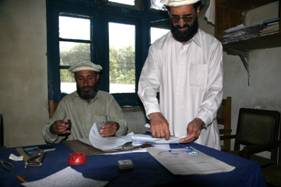 Because the
Kalash valleys are viewed as a rather special area (for a start, they are not
Muslim) and so close to the Afghan border (about 10 miles over the mountains)
you have to get a special permit to visit. So, off we all drove to the central
police station to get the appropriate permits and stamps. I’m not sure whether
it was reassuring or not to see a group of officers with “Anti Terrorist
Force” on their jackets. Talking to them revealed Chitral to be a bit
of a soft posting (as there weren’t any terrorists) compared to Peshawar or Swat. No one I spoke to during the whole trip had a good word to say for the
Taliban or their ideas (certainly not the relatively relaxed Ismailis), but
they were universally critical of the USA as well. For the permit process you
really needed your passport, but when I explained that mine was in my case
under tarpaulin and tied to the back of the jeep they were content to accept
the scanned copy. The two clerks and Ehsan filled in lots of forms which were
all stamped. Then we were wheeled in to see the chief who was far more
interested in what we thought of Pakistan and its people. Permits were of course
granted.
Because the
Kalash valleys are viewed as a rather special area (for a start, they are not
Muslim) and so close to the Afghan border (about 10 miles over the mountains)
you have to get a special permit to visit. So, off we all drove to the central
police station to get the appropriate permits and stamps. I’m not sure whether
it was reassuring or not to see a group of officers with “Anti Terrorist
Force” on their jackets. Talking to them revealed Chitral to be a bit
of a soft posting (as there weren’t any terrorists) compared to Peshawar or Swat. No one I spoke to during the whole trip had a good word to say for the
Taliban or their ideas (certainly not the relatively relaxed Ismailis), but
they were universally critical of the USA as well. For the permit process you
really needed your passport, but when I explained that mine was in my case
under tarpaulin and tied to the back of the jeep they were content to accept
the scanned copy. The two clerks and Ehsan filled in lots of forms which were
all stamped. Then we were wheeled in to see the chief who was far more
interested in what we thought of Pakistan and its people. Permits were of course
granted.
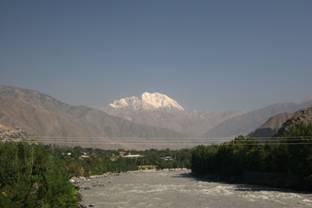
The Chitral River flows into Afghanistan where it becomes the Kabul River before flowing back into Pakistan to join the Indus near Attock, and as we crossed over it there were some great views to the north and to the massif of Tirich Mir (7,706 meters (25,600ft)) which is the most southerly of the really high Hindu Kush mountains in Pakistan. Just after the river and the village of Ayun we passed through the final police checkpoint before we entered the Kalash valleys.
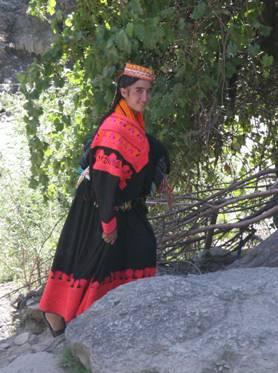 The entry to
the valley was very narrow and the jeep track pretty difficult – and to say
that after over two weeks in Pakistan means it was difficult; it
undercuts the cliff face and there is a big drop to the river below.
The entry to
the valley was very narrow and the jeep track pretty difficult – and to say
that after over two weeks in Pakistan means it was difficult; it
undercuts the cliff face and there is a big drop to the river below.
We were to stay in the village of Balanguru which is a picturesque village of about 60 stone and wood houses on a small stream that in turn flows into the main river of the valley. The stream itself is used for everything – washing self/clothes/pots, drinking water for goats and sheep and water for cooking; it even flows under our guesthouse. The guesthouse has been relatively recently built by the village elder and was the place where Michael Palin and his crew doing the Himalaya TV series.
The Kalash are very different from the other peoples of Pakistan. For a start they are non-Muslim; I guess you would describe them as ‘animist’ or ‘pagan’ but whether this does justice to their beliefs or not I am not really sure. One thing is for certain and that is that they live in a very small, quite isolated are of just three valleys west of Chitral and no one quite knows what their origins are; some say they are the descendants of Alexander the Great’s army – I suppose DNA testing will ultimately decide, but will it destroy the ‘romance’ of the issue?. The valleys are quite difficult to enter and their remoteness meant that, for example, they did not use money till the 1990’s. They are definitely on the ‘tourist trail’ now though, though at present many of the villages, like Balanguru, remain isolated, very poor, and unique. They are also under severe pressure from the surrounding Muslim ‘authorities’ to convert to Islam – you can imagine the pressure on a bright kid for example; “I’m sure you could go to high school or even university, it’s a shame that you are not a Muslim though........”.
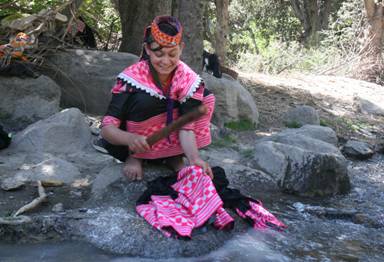
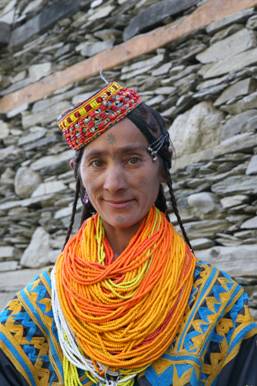
What really makes the Kalash stand out is their relatively liberal (at least in Muslim Pakistan) attitude to women and the colourful clothes that the women and girls wear. They usually wear black dresses augmented by incredibly colourful beaded necklaces and headdresses. One of the amazing things though is that it was not always so; drab black and brown was the traditional wear till much cheaper colourful materials and beads became available at the end of the 19th century and the Kalash adopted this with gusto. The colourful dresses are in no way just put on for tourists, this is genuinely the every-day wear; doesn’t make them any less photogenic though. Obviously they wanted to sell us some handicrafts. These were absolutely lovely and much time and effort had gone into their making, and obviously we bought some. Another mantra I will repeat is that 5-600 rupees meant so much more to them than £5-6 to us (westerners).
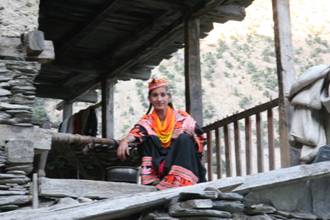
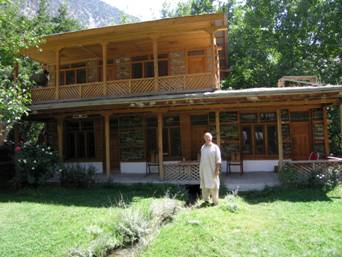
There are two other ‘problems’ with the colourful attire. Firstly it can make you forget how seriously poor the Kalash are and what an incredibly hard life they lead. Whilst the villages do mostly have electricity and some have a treated water supply, the valleys are very narrow and steep and agriculture is difficult and they are largely cut off by snow in the (long) winter. The other thing is that, as in many other parts of the ‘third world’, washing is not a priority as it is with us, so people can ‘whiff’ a bit. They are however, extremely friendly and although our guest house was quite basic it was the best accommodation they had in Balanguru village and we genuinely considered it an honour and a privilege to be able to stay there; indeed, you could stay in the more commercially developed village/valley of Bumburet and fail to get anything like the same feeling for the Kalash and their way of life.
We realised that it didn’t do to enquire too carefully how/where the cooking pots were washed or where the water for cooking came from, but we always felt we were given the best they had, and we never got ill – a mantra it is well worth repeating. Both mornings we were there we had honey for breakfast – not the refined and centrifuged stuff, but honey freshly collected from a nest up a tree, in the mountains and complete with honey comb and ‘bits’. The Kalash attitude to agriculture other than the growing of wheat or maize is interesting. If there is a walnut tree they will pick and eat the walnuts, likewise if there are grapevines (they even make wine), or mulberries or apricots – they just don’t actually cultivate them in the way we would understand the term. In summer, some of the men take the herds of goats high up into the mountains. Goats are most useful as they are a source of wool, meat, milk and cheese and they will eat anything.
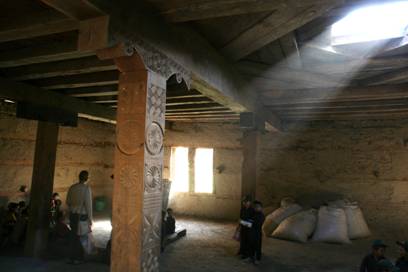
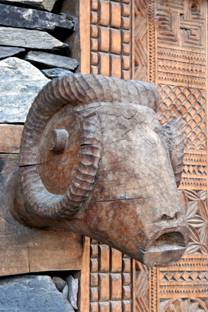
We were taken on a tour of the village which involved going up to one of the male temples. Kalash beliefs are interesting – everything is either ‘pure’ or ‘impure’. Men are ‘pure’, women are ‘impure’. Each has their own rolls, responsibilities, fields to tend and jobs, and the two do not mix. Likewise, there are ‘male’ temples and ‘female’ temples. When women are menstruating they must take their children to the ‘menstruation house’ are the bottom of the village till they are finished. Births take place in the same building. Anyway, the temple was up a very steep and loose soil slope which we struggled with and which caused our villager no problem at all. We both had a look inside, though in retrospect we suspect Margaret shouldn’t have entered.
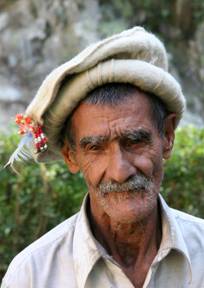
After the temple we walked along a water channel (note still the importance of irrigation) to see some old carved stone coffins – the Kalash used to leave the dead on the surface in open coffins, but that is not done anymore (I suspect it is not permitted).
Later in the afternoon we went to the small village school and gave them an atlas and some pens and some pencils. There were four small classes, but only two teachers, so two of the classes sat working by themselves and were being supervised by one of the elders of the village. All the children were well behaved and getting on with some work.
.